- About Us(关于我们)
- Contact Us(联系我们)
- Math Competitions(数学竞赛)
- Math Education(数学教育)
- Online Courses
- Policies and Procedures
- Student Awards & Recognition
- Tutoring Center


A Complete List of Real SAT Essay Prompts (March 2005 – June 2015)
A complete compilation of real SAT essay prompts administered historically by the College Board for different test periods.
- Prompts: October 2014 – June 2015
- Prompts: October 2013 – June 2014
- Prompts: October 2012 – June 2013
- Prompts: October 2011 – June 2012
- Prompts: October 2010 – June 2011
- Prompts: October 2009 – June 2010
- Prompts: October 2008 – June 2009
- Prompts: October 2007 – June 2008
- Prompts: October 2006 – June 2007
- Prompts:_March 2005 – June 2006
SAT essay prompts contain a first part which is a passage or quote, followed by a second part which is the assignment.
For practice, you could write an entire essay on one of the prompts, or you could identify one historical, one literary, and one current event example that could be useful for each prompt. If you have taken a course at our center, you will remember that you should research and memorize 5 literary, 5 historical, and 5 current event examples on a variety of topics before you walk into the test. This strategy saves you valuable time and ensures your examples are detailed, accurate, and original.
For SAT Tips on the Writing section, please click: 25-Minute Essay Strategies .
Click HERE to find out more about SAT Prep!
2 responses to “ A Complete List of Real SAT Essay Prompts (March 2005 – June 2015) ”
Pingback: SAT Essay Scoring and Feedback | Ivy League Education Center
Pingback: 暑期是高中学生突击攻克SAT最关键的时段 | Ivy League Education Center
Leave a comment Cancel reply
Recent entries.
- 2024 Special Spring Session – Competitive Math Courses
- 2024 AMC 8 Results Just Announced — Ten Students Received Perfect Scores
- Online Intensive AMC 8/Mathcounts Prep (for 4th to 8th Graders) Special Spring Session (Advanced Geometry) Starting March 30
- Online Intensive AMC 10/12/ARML Prep (for 6th to 11th Graders) Special Spring Session (Geometry) Starting April 14
- Online Intensive AIME Prep Special Spring Session (Advanced Algebra) Starting April 14
- 2024 Spring – Competitive Math Courses
- 99 Students Qualified for the 2024 AIME and 2 Students Received Perfect Scores on the 2023 AMC 10/12
- Online Intensive AMC 8/Mathcounts Prep (for 4th to 8th Graders) Spring Weekend Course (Geometry) Starting Jan. 20
- Online Intensive AMC 10/12/ARML Prep (for 6th to 11th Graders) Spring Weekend Course (Geometry) Starting Feb. 11
- Online Intensive AIME Prep Spring Weekend Course (Algebra) Starting Feb. 4
- 2024 AMC 8 Problems and Answers
- 2023 Winter – Competitive Math Courses
- 2024 AIME Qualifying Thresholds
- 2023 AMC 10B/12B Problems and Answers
- 2023 AMC 10A/12A Problems and Answers
- 2023 Fall – Competitive Math Courses
- 2023 Summer – Competitive Math Courses
- 2023 USAMO and USAJMO Awardees Announced — Congratulations to Eight USAMO Awardees and Seven USAJMO Awardees
- 2023 AMC 8 Results Just Announced — Eight Students Received Perfect Scores
- Some Hard Problems on the 2023 AMC 8 are Exactly the Same as Those in Other Previous Competitions
- Problem 23 on the 2023 AMC 8 is Exactly the Same as Problem 22 on Our 2022 AMC 8 Mock Test
- 96 Students Qualified for the 2023 AIME and 2 Students Received Perfect Scores on the 2022 AMC 10/12
- 2023 AMC 8 Problems and Answers
- Isabella Z. Won a Gold Medal and Team USA Earned First Place at 2022 European Girls’ Mathematical Olympiad
- Isabella Z. Competes in International Girls’ Math Olympiad
- 2022 USAMO and USAJMO Qualifiers Announced — Seven Students Qualified for the USAMO and Seven Students for the USAJMO
- 2022 AMC 8 Results Just Announced — Ten Students Received Perfect Scores
- It Is Easier to Qualify for the AIME Through the AMC 12 Than Through the AMC 10
- 93 Students Qualified for the 2022 AIME and 2 Students Received Perfect Scores on the 2021 Fall AMC 10/12
- Congratulations to Isabella Z. for Winning the Akamai AMC 12B Award
- Advantages and Benefits of Taking AMC 12 Rather Than AMC 10
- How to Prepare for the AMC 8
- Online Mental Math (Special Winter Session) Starting December 23
- How the AMC contests can help you get into the Ivy League Schools
- The 2020 AMC 10/12 Contests Recycle Four Previous AIME Problems
- 20 Sets of AMC 12 Mock Test with Detailed Solutions
- 20 Sets of AMC 10 Mock Test with Detailed Solutions
- 20 Sets of AMC 8 Mock Test with Detailed Solutions
- AMC 8/10/12/AIME Problems and Answers
- 2024 USAMO and USAJMO Qualifying Thresholds
- 2024 AMC 8 Honor Roll and Honor Roll of Distinction Cut-off Scores
- 路透社大放厥词:中国空气污染减少,太清洁导致气温升高
- 香港消散的優越感殘影(葉家興)
- 120 Full-length Official AMC Tests are a Golden Resource to Our AMC 10/12 Prep Program
- 1596 Redesigned SAT Math Questions from the College Board
- 19 Full-length Real Redesigned SATs and PSATs are a Golden Resource to Our SAT Prep Program
- 20 Sets of AMC 10 Mock Test with Detailed Solutions
- 20 Sets of AMC 12 Mock Test with Detailed Solutions
- 20 Sets of AMC 8 Mock Test with Detailed Solutions
- 2014 AMC 8 Winners for the U.S. Ivy League Education Center
- 2015 AMC 8 Results Announced
- 2015 Summer – SAT/PSAT/ACT Prep
- 2016 AIME Qualifiers Announced — 36 Students Qualified for the AIME
- 2016 AMC 8 Results Announced — Eleven Students Received Perfect Scores
- 2016 Spring – Competitive Math Courses
- 2016 Summer – SAT/PSAT/ACT Prep
- 2016 Summer — Math Enrichment Program
- 2017 AIME Qualifiers Announced — 61 Students Qualified for the AIME
- 2017 AMC 8 Honor Roll and Distinguished Honor Roll Cut-off Scores
- 2017 AMC 8 Results Just Announced — Seven Students Received Perfect Scores
- 2018 AMC 8 Results Just Announced — Three Students Received Perfect Scores
- 2019 AMC 8 Results Just Announced — Eight Students Received Perfect Scores
- 2019 USAMO and USAJMO Qualifiers Announced — Four Students Qualified for the USAMO and Four Students for the USAJMO
- 2020 AIME Qualifiers Announced — 82 Students Qualified for the AIME
- 365-hour Project to Qualify for the AIME through the AMC 10/12 Contests
- A Little Competition can Inspire Students to Greater Achievement
- AMC 10 versus AMC 12
- AMC 10/12 Historical Results of Cutoff Scores from 2000 to 2017
- AMC 8 Historical Results from 2011 to 2018
- American Mathematics Competitions (AMC) Materials
- American Mathematics Contest 10 (AMC 10)
- American Mathematics Contest 12 — AMC 12
- Attendance/Absence/Cancellation/Makeup Lesson Policy
- Cutoff scores for AIME qualification in 2016
- 独家专访哈佛招生办主任:哈佛究竟需要什么样的学生?— Interview with Director of Admissions for Harvard
- Every Student Should Take Both the AMC 10A/12A and 10 B/12B!
- Girls should attend math competitions — 女生更应参加数学竞赛
- Great Benefits of Math Competitions
- Helpful Links
- Homework assignments are a fundamental part of our courses
- Homework Correction is very Important — We Give an Extensive Correction of the Incorrect Answers of All Homework
- How the AMC contests can help you get into the Ivy League Schools
- Intensive SAT Subject Test in Math Level 2 Prep Course
- List of Mathematics Competitions
- Math Competitions
- Math Kangaroo Contest
- Mathcounts — Challenging Students to Achieve in Math!
- Mathematics competitions are NOT mysterious, and every student can attend them! — 数学竞赛绝非神秘,每个学生都可参加!
- Notable Achievements of Our Students
- Online SAT Critical Reading and Writing Tutoring
- Optimal Strategies to Solve Hard AMC Geometry Problems
- Payment and Refund Policy
- Premier National Mathematics Competition — AMC 8
- Recent USAMO and USAJMO Qualification Indices
- Small-sized Class Instruction Focused Model
- Some Hard Problems on the 2016 AMC 8 are Exactly the Same as Previous Problems on the AMC 10/12 and the Other Competitions
- Some Hard Problems on the 2017 AMC 10A/12A are Totally the Same as Previous Problems on the AMC 10/12
- Some Problems on the 2016 AMC 10/12 are Exactly the Same as Previous AMC/ARML Problems
- Special Program for SAT Subject Math Level 2 Tutoring & Test Prep
- Students Can Easily Qualify for the AIME Through the AMC 12 During 11th and 12th Grade
- Summer is the Golden Time to Prepare for the SAT (PSAT) Test
- The 2020 AMC 10/12 Contests Recycle Three Previous AIME Problems
- The AMC 10 and AMC 12 Have 10-15 Questions in Common
- The Big Value of Middle School Math Competitions
- The Hardest Problems on the 2017 AMC 8 are Extremely Similar to Previous Problems on the AMC 8, 10, 12, Kangaroo, and MathCounts
- The Hardest Problems on the 2018 AMC 8 are Nearly Identical to Former Problems on the AMC 8, 10, 12, and MathCounts
- This Year It Was Much Easier to Qualify for the AIME Through the AMC 12A Than Through the AMC 10A
- Using the Ruler, Protractor, and Compass to Solve the Hardest Geometry Problems on the 2016 AMC 8
- Warmest congratulations to Isabella Z. and Zipeng L. for being accepted into the Math Olympiad Program!
- Why Discrete Math is very Important
- Why Math Competitions are so Important to Girls?
- 利用College Board的真题培训学生在SAT Subject Tests in Math考试中赢得高分
- 暑期是高中学生突击攻克SAT最关键的时段

- Already have a WordPress.com account? Log in now.
- Subscribe Subscribed
- Copy shortlink
- Report this content
- View post in Reader
- Manage subscriptions
- Collapse this bar

SAT Essay Prompts: Analysis and Practice

Analyzing and practicing SAT essay prompts is crucial for success on the Writing and Language section of the SAT. Here's a comprehensive guide to help you understand SAT essay prompts, analyze them effectively, and practice writing essays that meet the SAT's expectations:
Understanding SAT Essay Prompts
1. Prompt Structure: SAT essay prompts typically consist of a passage or excerpt followed by a question that asks you to analyze the author's argument, rhetorical strategies, or persuasive techniques.
2. Key Components: Pay attention to the main argument or thesis presented in the passage, as well as the evidence and rhetorical devices used to support it.
3. Purpose of Analysis: The SAT essay prompt is designed to assess your ability to analyze and evaluate an author's argument, rather than to express your own opinion or personal experiences.
Analyzing SAT Essay Prompts
1. Identify the Main Argument: Read the passage carefully to understand the author's main argument or thesis. Highlight key points and evidence used to support it.
2. Evaluate Rhetorical Strategies: Identify and analyze the rhetorical devices and persuasive techniques used by the author, such as appeals to emotion, logic, or authority.
3. Consider Tone and Style: Pay attention to the author's tone and writing style, as well as any patterns or recurring themes in the passage.
4. Assess Effectiveness: Evaluate how effectively the author presents their argument and persuades the reader to agree with their point of view.
Practicing SAT Essay Writing
1. Time Yourself: Set a timer for 50 minutes (the allotted time for the SAT essay) and practice writing essays under timed conditions to simulate test-day conditions.
2. Choose Prompts: Select SAT essay prompts from official SAT practice tests, review books, or online resources. Aim to practice with a variety of prompts to improve your versatility.
3. Outline Your Response: Before writing your essay, create a brief outline outlining your main points and the structure of your argument. This will help you stay focused and organized.
4. Write Clear, Concise Responses: Write in clear, concise language, and provide specific examples and evidence from the passage to support your analysis.
5. Edit and Revise: Take time to review and revise your essay after you've finished writing. Check for grammar, punctuation, and spelling errors, and make any necessary revisions to strengthen your argument.
6. Seek Feedback: Ask a teacher, tutor, or knowledgeable peer to review your essays and provide constructive feedback. Use their suggestions to improve your writing skills.
Tips for Success
1. Practice Regularly: Consistent practice is key to improving your SAT essay writing skills. Aim to practice writing essays on a regular basis to build confidence and familiarity with the format.
2. Read Critically: Read a variety of texts, including articles, essays, and editorials, and practice analyzing the author's argument, tone, and rhetorical strategies.
3. Stay Updated: Familiarize yourself with current events and social issues, as SAT essay prompts often draw from contemporary topics and debates.
4. Stay Calm and Focused: On test day, stay calm and focused, and trust in your preparation and practice. Remember to manage your time effectively and pace yourself throughout the essay-writing process.
By understanding SAT essay prompts, analyzing them effectively, and practicing writing essays that meet the SAT's expectations, you can improve your performance on the SAT Writing and Language section and work towards achieving your target score.
You Might Also Like

Know Why Demonstrated Interest is Crucial
If you want to gain admission in your dream college, you have to show your demonstrated interest to join the institution and why it is crucial

The Ultimate Guide to College Interviews
College interviews, although nerve wrecking, can be the best chance for you to impress the admissions officer. We give you tips on how to ace your interview.

Brainstorming for College Essays
This Article is intended to help you brainstorm and begin writing your personal statement essay and all the other college essays. This is a key step to write persuasive college essays

Free Resources
SAT Essay Prompts | Real World Examples
The best way to get used to what you’ll see on the SAT Essay is…seeing actual SAT Essay prompts and readings. So we have two official practice prompts for you to look at straight from the College Board.
When tackling the SAT Essay, be mindful of these dos and don’ts that’ll help you write it effectively on test day.
SAT Essay Prompt 1
Here are the actual directions to follow:
“As you read the passage below, consider how Paul Bogard uses
- evidence, such as facts or examples, to support claims.
- reasoning to develop ideas and to connect claims and evidence.
- stylistic or persuasive elements, such as word choice or appeals to emotion, to add power to the ideas expressed.”
SAT Essay Prompt 1 Reading Passage
“ Adapted from Paul Bogard, “Let There Be Dark.” ©2012 by Los Angeles Times. Originally published December 21, 2012.
At my family’s cabin on a Minnesota lake, I knew woods so dark that my hands disappeared before my eyes. I knew night skies in which meteors left smoky trails across sugary spreads of stars. But now, when 8 of 10 children born in the United States will never know a sky dark enough for the Milky Way, I worry we are rapidly losing night’s natural darkness before realizing its worth. This winter solstice, as we cheer the days’ gradual movement back toward light, let us also remember the irreplaceable value of darkness.
All life evolved to the steady rhythm of bright days and dark nights. Today, though, when we feel the closeness of nightfall, we reach quickly for a light switch. And too little darkness, meaning too much artificial light at night, spells trouble for all.
Already the World Health Organization classifies working the night shift as a probable human carcinogen, and the American Medical Association has voiced its unanimous support for “light pollution reduction efforts and glare reduction efforts at both the national and state levels.” Our bodies need darkness to produce the hormone melatonin, which keeps certain cancers from developing, and our bodies need darkness for sleep. Sleep disorders have been linked to diabetes, obesity, cardiovascular disease, and depression, and recent research suggests one main cause of “short sleep” is “long light.” Whether we work at night or simply take our tablets, notebooks, and smartphones to bed, there isn’t a place for this much artificial light in our lives.
The rest of the world depends on darkness as well, including nocturnal and crepuscular species of birds, insects, mammals, fish, and reptiles. Some examples are well known—the 400 species of birds that migrate at night in North America, the sea turtles that come ashore to lay their eggs—and some are not, such as the bats that save American farmers billions in pest control and the moths that pollinate 80% of the world’s flora. Ecological light pollution is like the bulldozer of the night, wrecking habitat and disrupting ecosystems several billion years in the making. Simply put, without darkness, Earth’s ecology would collapse…
In today’s crowded, louder, more fast-paced world, night’s darkness can provide solitude, quiet and stillness, qualities increasingly in short supply. Every religious tradition has considered darkness invaluable for a soulful life, and the chance to witness the universe has inspired artists, philosophers, and everyday stargazers since time began. In a world awash with electric light…how would Van Gogh have given the world his “Starry Night”? Who knows what this vision of the night sky might inspire in each of us, in our children or grandchildren?
Yet all over the world, our nights are growing brighter. In the United States and Western Europe, the amount of light in the sky increases an average of about 6% every year. Computer images of the United States at night, based on NASA photographs, show that what was a very dark country as recently as the 1950s is now nearly covered with a blanket of light. Much of this light is wasted energy, which means wasted dollars. Those of us over 35 are perhaps among the last generation to have known truly dark nights. Even the northern lake where I was lucky to spend my summers has seen its darkness diminish.
It doesn’t have to be this way. Light pollution is readily within our ability to solve, using new lighting technologies and shielding existing lights. Already, many cities and towns across North America and Europe are changing to LED streetlights, which offer dramatic possibilities for controlling wasted light. Other communities are finding success with simply turning off portions of their public lighting after midnight. Even Paris, the famed “city of light,” which already turns off its monument lighting after 1 a.m., will this summer start to require its shops, offices, and public buildings to turn off lights after 2 a.m. Though primarily designed to save energy, such reductions in light will also go far in addressing light pollution. But we will never truly address the problem of light pollution until we become aware of the irreplaceable value and beauty of the darkness we are losing.”
SAT Essay Prompt 2
“As you read the passage below, consider how Dana Gioia uses
SAT Essay Prompt 2 Reading Passage
“Adapted from Dana Gioia, “Why Literature Matters” ©2005 by The New York Times Company. Originally published April 10, 2005.
[A] strange thing has happened in the American arts during the past quarter-century. While income rose to unforeseen levels, college attendance ballooned, and access to information increased enormously, the interest young Americans showed in the arts—and especially literature—actually diminished.
According to the 2002 Survey of Public Participation in the Arts, a population study designed and commissioned by the National Endowment for the Arts (and executed by the US Bureau of the Census), arts participation by Americans has declined for eight of the nine major forms that are measured… The declines have been most severe among younger adults (ages 18–24). The most worrisome finding in the 2002 study, however, is the declining percentage of Americans, especially young adults, reading literature.
That individuals at a time of crucial intellectual and emotional development bypass the joys and challenges of literature is a troubling trend. If it were true that they substituted histories, biographies, or political works for literature, one might not worry. But book reading of any kind is falling as well.
That such a longstanding and fundamental cultural activity should slip so swiftly, especially among young adults, signifies deep transformations in contemporary life. To call attention to the trend, the Arts Endowment issued the reading portion of the Survey as a separate report, “Reading at Risk: A Survey of Literary Reading in America.”
The decline in reading has consequences that go beyond literature. The significance of reading has become a persistent theme in the business world. The February issue of Wired magazine, for example, sketches a new set of mental skills and habits proper to the 21st century, aptitudes decidedly literary in character: not “linear, logical, analytical talents,” author Daniel Pink states, but “the ability to create artistic and emotional beauty, to detect patterns and opportunities, to craft a satisfying narrative.” When asked what kind of talents they like to see in management positions, business leaders consistently set imagination, creativity, and higher-order thinking at the top.
Ironically, the value of reading and the intellectual faculties that it inculcates appear most clearly as active and engaged literacy declines. There is now a growing awareness of the consequences of nonreading to the workplace. In 2001 the National Association of Manufacturers polled its members on skill deficiencies among employees. Among hourly workers, poor reading skills ranked second, and 38 percent of employers complained that local schools inadequately taught reading comprehension.
The decline of reading is also taking its toll in the civic sphere… A 2003 study of 15- to 26-year-olds’ civic knowledge by the National Conference of State Legislatures concluded, “Young people do not understand the ideals of citizenship… and their appreciation and support of American democracy is limited.”
It is probably no surprise that declining rates of literary reading coincide with declining levels of historical and political awareness among young people. One of the surprising findings of “Reading at Risk” was that literary readers are markedly more civically engaged than nonreaders, scoring two to four times more likely to perform charity work, visit a museum, or attend a sporting event. One reason for their higher social and cultural interactions may lie in the kind of civic and historical knowledge that comes with literary reading…
The evidence of literature’s importance to civic, personal, and economic health is too strong to ignore. The decline of literary reading foreshadows serious long-term social and economic problems, and it is time to bring literature and the other arts into discussions of public policy. Libraries, schools, and public agencies do noble work, but addressing the reading issue will require the leadership of politicians and the business community as well…
Reading is not a timeless, universal capability. Advanced literacy is a specific intellectual skill and social habit that depends on a great many educational, cultural, and economic factors. As more Americans lose this capability, our nation becomes less informed, active, and independent-minded. These are not the qualities that a free, innovative, or productive society can afford to lose.”
[sat_three]
For more test strategy, college admissions, and scholarship application tips sign up for our FREE classes happening right now!
Related Articles

So You Think You Can Cheat on the Digital SAT?
Mar 26, 2024

Can You Take the SAT at Any Age?
Mar 19, 2024

A Comprehensive Digital SAT Prep Guide
Feb 27, 2024
Recent Posts
How hard is the act, navigating the college admissions process: a comprehensive guide for parents, top 10 secrets to raise your child's score.
Join Prep Expert Founder and Perfect SAT Scorer Shaan Patel for this exclusive event!
$200 OFF COUPON CODE
Subscribe to our emails and get $200 OFF any Prep Expert Online Course.
Enter the coupon code SHARKTANK200 to save $200 OFF any Prep Expert Online Course!
By providing your email address, you agree to our Privacy Policy and Terms & Conditions
No thanks, I’d prefer to pay full price.

SAT Essay Prompts (10 Sample Questions)
What does it take to get a high SAT Essay score, if not perfect it? Practice, practice and more practice! Know the tricks and techniques of writing the perfect SAT Essay, so that you can score perfect as well. That’s not a far off idea, because there actually is a particular “formula” for perfecting the SAT Essay test. Consider that every prompt has a format, and what test-takers are required to do remain the same- even if the passage varies from test to test.
The SAT Essay test will ask you to read an argument that is intended to persuade a general audience. You’ll need to discuss how proficient the author is in arguing their point. Analyze the argument of the author and create an integrated and structured essay that explains your analysis.
On this page, we will feature 10 real SAT Essay prompts that have been recently released online by the College Board. You can utilize these Essay SAT prompts as 10 sample SAT Essay questions for easy practice. This set of SAT Essay prompts is the most comprehensive that you will find online today.
The predictability of the SAT Essay test necessitates students to perform an organized analytical method of writing instead of thinking up random ideas on their own. Consider that what you will see before and after the passage remains consistent. It is recommended that you initially read and apply the techniques suggested in writing the perfect SAT Essay (🡨link to SAT Essay —- SAT Essay Overview: How to Get a Perfect Score) before proceeding on using the following essay prompts for practice.
Check our SAT Reading Practice Tests
10 Official SAT Essay Prompts For Practice
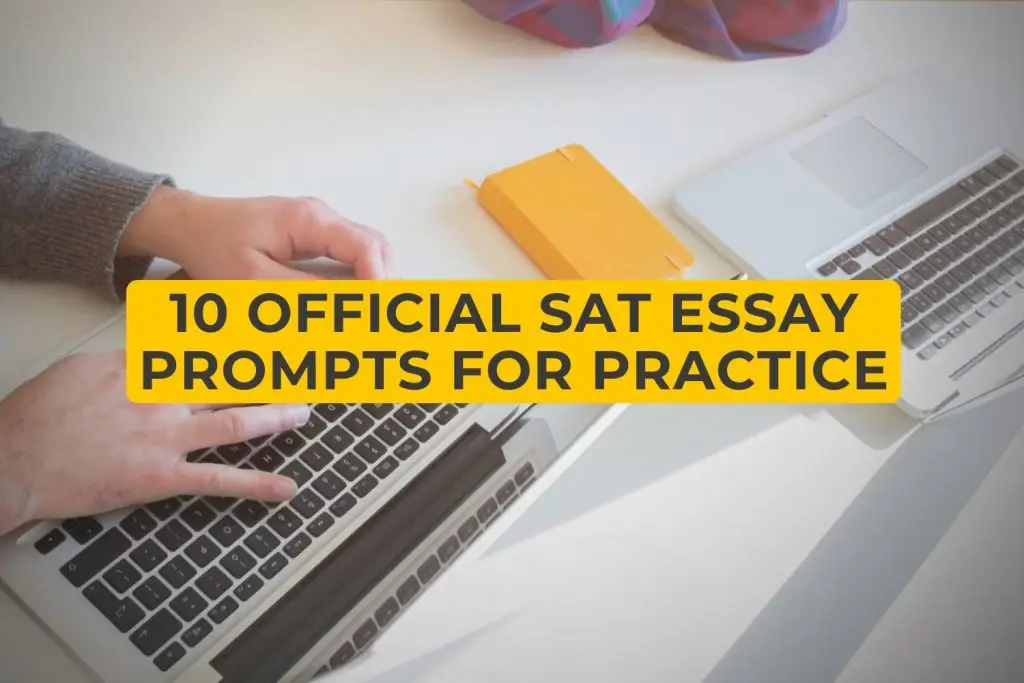
Practice Test 1
“Write an essay in which you explain how Jimmy Carter builds an argument to persuade his audience that the Arctic National Wildlife Refuge should not be developed for industry.”
Practice Test 2
“Write an essay in which you explain how Martin Luther King Jr. builds an argument to persuade his audience that American involvement in the Vietnam War is unjust.”
Practice Test 3
“Write an essay in which you explain how Eliana Dockterman builds an argument to persuade her audience that there are benefits to early exposure to technology.”
Practice Test 4
“Write an essay in which you explain how Paul Bogard builds an argument to persuade his audience that natural darkness should be preserved.”
Practice Test 5
“Write an essay in which you explain how Eric Klinenberg builds an argument to persuade his audience that Americans need to greatly reduce their reliance on air-conditioning.”
Practice Test 6
“Write an essay in which you explain how Christopher Hitchens builds an argument to persuade his audience that the original Parthenon sculptures should be returned to Greece.”
Practice Test 7
“Write an essay in which you explain how Zadie Smith builds an argument to persuade her audience that public libraries are important and should remain open”
Practice Test 8
“Write an essay in which you explain how Bobby Braun builds an argument to persuade his audience that the US government must continue to invest in NASA.”
Practice Test 9
“Write an essay in which you explain how Richard Schiffman builds an argument to persuade his audience that Americans need to work fewer hours.”
Practice Test 10
“Write an essay in which you explain how Todd Davidson builds an argument to persuade his audience that the US government must continue to fund national parks.”
Visit our SAT Writing Practice Tests
What Is An Example Of A SAT Essay That Obtained A Perfect Score?
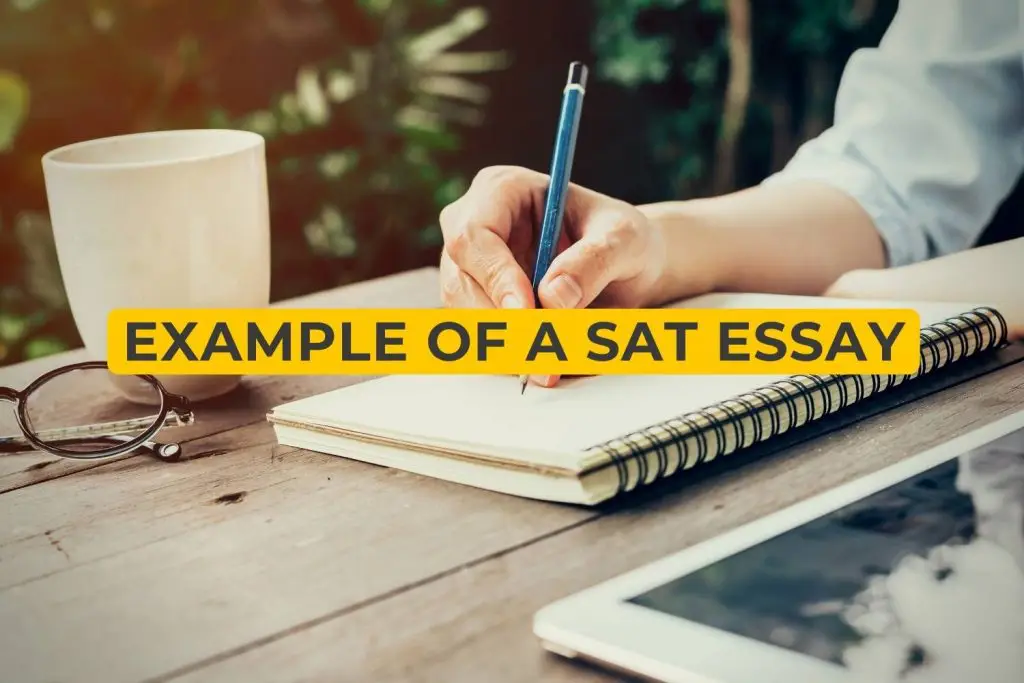
Here is an example of Practice Test 4 above and how a perfect SAT Essay in response to it looks like. This has been published in the College Board website.
Answer Essay with Perfect Score:
In response to our world’s growing reliance on artificial light, writer Paul Bogard argues that natural darkness should be preserved in his article “Let There be dark”. He effectively builds his argument by using a personal anecdote, allusions to art and history, and rhetorical questions.
Bogard starts his article off by recounting a personal story – a summer spent on a Minnesota lake where there was “woods so dark that [his] hands disappeared before [his] eyes.” In telling this brief anecdote, Bogard challenges the audience to remember a time where they could fully amass themselves in natural darkness void of artificial light. By drawing in his readers with a personal encounter about night darkness, the author means to establish the potential for beauty, glamour, and awe-inspiring mystery that genuine darkness can possess. He builds his argument for the preservation of natural darkness by reminiscing for his readers a first-hand encounter that proves the “irreplaceable value of darkness.” This anecdote provides a baseline of sorts for readers to find credence with the author’s claims.
Bogard’s argument is also furthered by his use of allusion to art – Van Gogh’s “Starry Night” – and modern history – Paris’ reputation as “The City of Light”. By first referencing “Starry Night”, a painting generally considered to be undoubtedly beautiful, Bogard establishes that the natural magnificence of stars in a dark sky is definite. A world absent of excess artificial light could potentially hold the key to a grand, glorious night sky like Van Gogh’s according to the writer. This urges the readers to weigh the disadvantages of our world consumed by unnatural, vapid lighting. Furthermore, Bogard’s alludes to Paris as “the famed ‘city of light’”. He then goes on to state how Paris has taken steps to exercise more sustainable lighting practices. By doing this, Bogard creates a dichotomy between Paris’ traditionally alluded-to name and the reality of what Paris is becoming – no longer “the city of light”, but moreso “the city of light…before 2 AM”. This furthers his line of argumentation because it shows how steps can be and are being taken to preserve natural darkness. It shows that even a city that is literally famous for being constantly lit can practically address light pollution in a manner that preserves the beauty of both the city itself and the universe as a whole
Finally, Bogard makes subtle yet efficient use of rhetorical questioning to persuade his audience that natural darkness preservation is essential. He asks the readers to consider “what the vision of the night sky might inspire in each of us, in our children or grandchildren?” in a way that brutally plays to each of our emotions. By asking this question, Bogard draws out heartfelt ponderance from his readers about the affecting power of an untainted night sky. This rhetorical question tugs at the readers’ heartstrings; while the reader may have seen an unobscured night skyline before, the possibility that their child or grandchild will never get the chance sways them to see as Bogard sees. This strategy is definitively an appeal to pathos, forcing the audience to directly face an emotionally-charged inquiry that will surely spur some kind of response. By doing this, Bogard develops his argument, adding gutthral power to the idea that the issue of maintaining natural darkness is relevant and multifaceted.
Writing as a reaction to his disappointment that artificial light has largely permeated the prescence of natural darkness, Paul Bogard argues that we must preserve true, unaffected darkness. He builds this claim by making use of a personal anecdote, allusions, and rhetorical questioning.
Related Topic: SAT Requirements
This response scored a 4/4/4.
Reading—4: This response demonstrates thorough comprehension of the source text through skillful use of paraphrases and direct quotations. The writer briefly summarizes the central idea of Bogard’s piece ( natural darkness should be preserved ; we must preserve true, unaffected darkness ), and presents many details from the text, such as referring to the personal anecdote that opens the passage and citing Bogard’s use of Paris’ reputation as “The City of Light.” There are few long direct quotations from the source text; instead, the response succinctly and accurately captures the entirety of Bogard’s argument in the writer’s own words, and the writer is able to articulate how details in the source text interrelate with Bogard’s central claim. The response is also free of errors of fact or interpretation. Overall, the response demonstrates advanced reading comprehension.
Analysis—4: This response offers an insightful analysis of the source text and demonstrates a sophisticated understanding of the analytical task. In analyzing Bogard’s use of personal anecdote, allusions to art and history, and rhetorical questions , the writer is able to explain carefully and thoroughly how Bogard builds his argument over the course of the passage. For example, the writer offers a possible reason for why Bogard chose to open his argument with a personal anecdote, and is also able to describe the overall effect of that choice on his audience ( In telling this brief anecdote, Bogard challenges the audience to remember a time where they could fully amass themselves in natural darkness void of artificial light. By drawing in his readers with a personal encounter…the author means to establish the potential for beauty, glamour, and awe-inspiring mystery that genuine darkness can possess…. This anecdote provides a baseline of sorts for readers to find credence with the author’s claims ). The cogent chain of reasoning indicates an understanding of the overall effect of Bogard’s personal narrative both in terms of its function in the passage and how it affects his audience. This type of insightful analysis is evident throughout the response and indicates advanced analytical skill.
Writing—4: The response is cohesive and demonstrates highly effective use and command of language. The response contains a precise central claim ( He effectively builds his argument by using personal anecdote, allusions to art and history, and rhetorical questions ), and the body paragraphs are tightly focused on those three elements of Bogard’s text. There is a clear, deliberate progression of ideas within paragraphs and throughout the response. The writer’s brief introduction and conclusion are skillfully written and encapsulate the main ideas of Bogard’s piece as well as the overall structure of the writer’s analysis. There is a consistent use of both precise word choice and well-chosen turns of phrase ( the natural magnificence of stars in a dark sky is definite , our world consumed by unnatural, vapid lighting , the affecting power of an untainted night sky ). Moreover, the response features a wide variety in sentence structure and many examples of sophisticated sentences ( By doing this, Bogard creates a dichotomy between Paris’ traditionally alluded-to name and the reality of what Paris is becoming – no longer “the city of light”, but moreso “the city of light…before 2AM” ). The response demonstrates a strong command of the conventions of written English. Overall, the response exemplifies advanced writing proficiency.
Related Topics:
- Practice Tests for SAT Reading
- SAT Writing And Language Practice Tests
- SAT Languages Test
- SAT Essay Test SAT Writing Practice Tests
- SAT Science Test, Topics & Subjects Content
- SAT Registration
- SAT Test Dates
- SAT vs ACT, Which One Should You Take?
- Why Take the SAT?


Choose Your Test
Sat / act prep online guides and tips, 6 sat essay examples to answer every prompt.
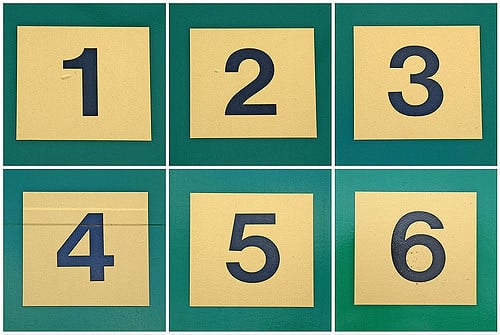
Just as with most essays, the major secret to excelling on the SAT essay is to pre-plan the examples and evidence you want to use.
"But wait!" I hear you cry. "Can you do that on the new SAT essay? Isn’t the point of the essay that you’re supposed to be using information from the passage in your answer, which you don’t know about ahead of time?"
The answer: Yes and no. While the specifics of each example will obviously change, depending on the passage, the types of examples you choose to discuss (and the way you explain each example builds the author’s argument) can be defined, and thus prepared for, ahead of time.
In this article, we give you 6 good SAT essay examples you’ll be able to find in nearly every prompt the SAT throws at you. By assembling a collection of these reliable types of evidence that can be used to answer most prompts, you'll cut down on planning time and significantly increase the amount you can write, making you able to walk into every SAT essay confident in your abilities.
feature image credit: 1 to 9 mosaic , cropped/Used under CC BY-NC-SA 2.0 .
UPDATE: SAT Essay No Longer Offered
(adsbygoogle = window.adsbygoogle || []).push({});.
In January 2021, the College Board announced that after June 2021, it would no longer offer the Essay portion of the SAT (except at schools who opt in during School Day Testing). It is now no longer possible to take the SAT Essay, unless your school is one of the small number who choose to offer it during SAT School Day Testing.
While most colleges had already made SAT Essay scores optional, this move by the College Board means no colleges now require the SAT Essay. It will also likely lead to additional college application changes such not looking at essay scores at all for the SAT or ACT, as well as potentially requiring additional writing samples for placement.
What does the end of the SAT Essay mean for your college applications? Check out our article on the College Board's SAT Essay decision for everything you need to know.
Why You Can Prep SAT Essay Examples Before Test Day
The SAT essay prompts have several important things in common:
- They’re all passages that try to convince the reader of the veracity of the author’s claim
- They’re all around the same length (650-750 words)
- They’re all meant to be analyzed and written about in a relatively short period of time (50 minutes)
This means that you can have a pretty good idea ahead of time of what types of argument-building techniques you might see when you open the booklet on test day.
The main techniques the author uses aren't going to be overly complex (like the first letter of every word spelling out a secret code), because you just don’t have the time to analyze and write about complex techniques. B ecause of that, you can prepare yourself with SAT essay examples that’ll be likely found across persuasive passages about many different issues .
Naturally, for each passage you're going to want to play to its particular strengths—if there are a lot of facts/statistics, make sure to discuss that; if it dwells more on personal anecdotes/appeals to emotion, discuss those. However, if you struggle with analysis in a short period of time, memorizing these categories of examples ahead of time can give you a helpful checklist to go through when reading the SAT essay prompt and point you in the right direction.
Below, we've chosen two examples of evidence, two examples of reasoning, and two examples of stylistic/persuasive elements you can use as stellar evidence to support your thesis .
For each example below, we also show you how you can use the type of evidence to support your thesis across a range of prompts. This flexibility should prove to you how effective pre-planned examples are.
So, without further ado, onto our list of multipurpose support for any SAT Essay prompt.
Examples of Evidence
The most basic way author builds an argument is by supporting claims with evidence . There are many different kinds of evidence author might use to support her/his point, but I'm just going to discuss the two big ones I've seen in various official SAT Essay prompts. These two types of evidence are Facts and Statistics and Anecdotes .
Example Type 1: Facts and Statistics
Employing statistics and facts to bolster one's argument is one of the most unassailable methods authors can use to build an argument. This argument-building technique is particularly common in essays written about scientific or social studies-related topics, where specific data and facts are readily available.
How Can You Identify It?
Statistics usually show up in the form of specific numbers related to the topic at hand —maybe as percents, or maybe as a way to communicate other data.
Here are a couple of examples of statistics from an official SAT essay prompt, "Let There Be Dark" by Paul Bogard :
Example : 8 of 10 children born in the United States will never know a sky dark enough for the Milky Way
Example : In the United States and Western Europe, the amount of light in the sky increases an average of about 6% every year.
Factual evidence can also be in the form of non-numerical information. Often, you'll see facts presented with references to the research study, survey, expert, or other source from which they're drawn. Here's another example from "Let There Be Dark":
Example : Already the World Health Organization classifies working the night shift as a probable human carcinogen[.]
Why Is It Persuasive?
Facts and statistics are persuasive argument building techniques because the author isn't just making up reasons for why his/her argument could possibly be true— there's actually something (data, research, other events/information) that backs up the author's claim .
In the case of the examples above, Bogard presents specific data about issues with light pollution (8 in 10 children won't be able to see the Milky Way, light in the sky increases 6% annually) to back up his statements that light pollution is real, then goes on to present further information that indicates light pollution is a problem (working the night shift puts humans at risk for cancer).
By presenting information and facts, rather than just opinion and spin, Bogard empowers the reader to connect the dots on her own, which in turn gives the reader ownership over the argument and makes it more persuasive (since the reader is coming to the same conclusions on her own, rather than entirely relying on Bogard to tell her what to think).
Example Type 2: Anecdotes
Another form of evidence that is often used as an alternative to actual facts or statistics is the anecdote. This type of evidence is most often found in speeches or other sorts of essay prompts that are written as a personal address to the reader.
An anecdote is a short story about a real person or event . When an author discusses own personal experience or personal experience of someone they know or have heard of, that's anecdotal evidence.
Here's an example of (part of) an anecdote from an official SAT essay prompt that was adapted from a foreword by former U.S. President Jimmy Carter :
One of the most unforgettable and humbling experiences of our lives occurred on the coastal plain. We had hoped to see caribou during our trip, but to our amazement, we witnessed the migration of tens of thousands of caribou with their newborn calves. In a matter of a few minutes, the sweep of tundra before us became flooded with life, with the sounds of grunting animals and clicking hooves filling the air. The dramatic procession of the Porcupine caribou herd was a once-in-a-lifetime wildlife spectacle. We understand firsthand why some have described this special birthplace as “America’s Serengeti.”
Even though anecdotes aren't statistics or facts, they can be powerful because it’s more relatable/interesting to the reader to read an anecdote than to be presented with dry, boring facts. People tend to put more faith in experiences if they can personally connect with the experiences (even though that doesn't actually affect how likely or not a statement is to be true).
In the example above, rather than discussing the statistics that support the creation of wildlife refuges, Jimmy Carter instead uses an anecdote about experiencing the wonder of nature to illustrate the same point—probably more effectively.
By inviting the reader to experience vicariously the majesty of witnessing the migration of the Porcupine caribou, Carter activates the reader's empathy towards wildlife preservation and so makes it more likely that the reader will agree with him that wildlife refuges are important.

Examples of Reasoning
All authors use reasoning to some extent, but it’s not always a major part of how the author builds her/his argument. Sometimes, though, the support for a claim on its own might not seem that persuasive—in those cases, an author might then choose to use reasoning to explain how the evidence presented actually builds the argument.
Example Type 3: Counterarguments and Counterclaims
One way in which an author might use reasoning to persuade the reader to accept the claim being put forward is to discuss a counterargument, or counterclaim, to the author's main point. The discussion (and subsequent neutralization) of counterarguments is found in prompts across all subject areas.
A counterargument or counterclaim is simply another point of view that contradicts (either fully or partially) the author's own argument. When "some might claim," "however," or other contrast words and phrases show up in an essay prompt, the author is likely presenting a counterclaim.
Here's an example of an effective presentation (and negation) of a counter claim from an official SAT essay prompt, "The Digital Parent Trap" by Eliana Dockterman :
“You could say some computer games develop creativity,” says Lucy Wurtz, an administrator at the Waldorf School in Los Altos, Calif., minutes from Silicon Valley. “But I don’t see any benefit. Waldorf kids knit and build things and paint—a lot of really practical and creative endeavors.”
But it’s not that simple. While there are dangers inherent in access to Facebook, new research suggests that social-networking sites also offer unprecedented learning opportunities.
So how does bringing up an opposing point of view help an author build her argument? It may seem counterintuitive that discussing a counterargument actually strengthens the main argument. However, as you can see in the brief example above, giving some space to another point of view serves to make it seem as if the discussion’s going to be more “fair.” This is still true whether the author delves into the counterargument or if the author only briefly mentions an opposing point of view before moving on.
A true discussion of the counterargument (as is present in Dockterman's article) will also show a deeper understanding of the topic than if the article only presented a one-sided argument . And because the presence of a counterargument demonstrates that the author knows the topic well enough to be able to see the issue from multiple sides, the reader's more likely to trust that the author's claims are well-thought out and worth believing.
In the case of the Dockterman article, the author not only mentions the opposite point of view but also takes the time to get a quote from someone who supports the opposing viewpoint. This even-handedness makes her following claim that "it's not that simple" more believable, since she doesn't appear to be presenting a one-sided argument.

Example Type 4: Explanation of Evidence
In some cases, the clarity with which the author links her evidence and her claims is integral to the author's argument. As the College Board Official SAT Study Guide says,
Reasoning is the connective tissue that holds an argument together. It’s the “thinking” — the logic, the analysis — that develops the argument and ties the claim and evidence together."
Explanation of evidence is one of the trickier argument-building techniques to discuss (at least in my opinion), because while it is present in many essay prompts, it isn't always a major persuasive feature. You can pretty easily identify an author's explanation of evidence if the author connects a claim to support and explains it , rather than just throwing out evidence without much ceremony or linking to the claim; however, whether or not the explanation of the evidence is a major contributing factor to the author's argument is somewhat subjective.
Here's a pretty clear instance of a case where an author uses explanations of each piece of evidence she discusses to logically advance her argument (again from the Dockterman passage):
And at MIT’s Education Arcade, playing the empire-building game Civilization piqued students’ interest in history and was directly linked to an improvement in the quality of their history-class reports. The reason: engagement. On average, according to research cited by MIT, students can remember only 10% of what they read, 20% of what they hear and 50% of what they see demonstrated. But when they’re actually doing something themselves—in the virtual worlds on iPads or laptops—that retention rate skyrockets to 90%. This is a main reason researchers like Ito say the American Academy of Pediatrics’ recommendation of a two-hour screen-time limit is an outdated concept: actively browsing pages on a computer or tablet is way more brain-stimulating than vegging out in front of the TV.

Unfortunately, the explanation the Official SAT Study Guide gives for how to discuss an author's "reasoning" is a little vague:
You may decide to discuss how the author uses (or fails to use) clear, logical reasoning to draw a connection between a claim and the evidence supporting that claim.
But how exactly you should go about doing this? And wh y is it persuasive to clearly explain the link between evidence and claim?
In general, when an author explains the logic behind her argument or point, the reader can follow along and understand the author’s argument better (which in some cases makes it more likely the reader will agree with the author).
In the Dockterman example above, the author clearly lays out data ( Civilization leads to improvements in history class), a claim (this is because of engagement with the game and thus the subject material), provides data that back up that claim (retention rate skyrockets when students do things for themselves), and links that smaller claim to a larger concept (actively browsing pages on a computer or tablet is way more brain-stimulating than vegging out in front of the TV). This clear pattern of data-explanation-more data-more explanation enables the reader to follow along with Dockterman's points. It's more persuasive because, rather than just being told " Civilization leads to improvements in history" and having to take it on faith, the reader is forced to reenact the thinking processes that led to the argument, engaging with the topic on a deeper level.
Examples of Stylistic/Persuasive Elements
This final category of examples is the top layer of argument building. The foundation of a good argument is evidence, which is often explained and elucidated by reasoning, but it is often the addition of stylistic or persuasive elements like an ironic tone or a rhetorical flourish that seals the deal.
Example Type 5: Vivid Language
Vivid language is truly the icing on the persuasive cake. As with explanations of evidence, vivid language can be found across all topics of essay prompts (although it usually plays a larger role when the passage is lacking in more convincing facts or logic).
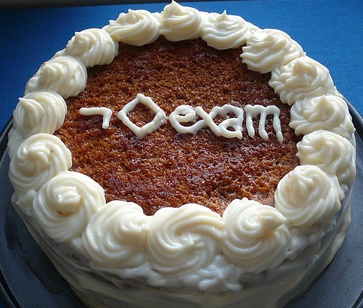
Vivid language is pretty easy to spot—it shows itself in similes, metaphors, adjectives, or any words that jump out at you that don’t seem to have purely functional purposes . Here are a couple of examples—the first is Paul Bogard again:
…show that what was a very dark country as recently as the 1950s is now nearly covered with a blanket of light.
This example is relatively restrained, using the metaphor of "a blanket of light" to add emphasis to Bogard's discussion of light pollution. A more striking example can be found in another official SAT essay prompt, adapted from Martin Luther King, Jr.'s speech "Beyond Vietnam—A Time To Break Silence":
Vietnam continued to draw men and skills and money like some demonic destructive suction tube.
Vivid language is an effective argument building device because it puts the reader in the author’s shoes and draws them into the passage . If used in moderation, vivid language will also make the topic more interesting for the reader to read, thus engaging them further.
In the excerpt taken from Martin Luther King Jr.'s speech above, the phrase "demonic destructive suction tube" is startling and provocative, meant to rouse the audience's indignation at the injustice and waste of the Vietnam war. If King had left out the second part of the sentence and only said, "Vietnam continued to draw men and skills and money," his point would not have had as big of an impact.
Example Type 6: Direct Addresses and Appeals to the Reader
The last category I'll be discussing in this article are direct addresses and appeals to the reader. These stylistic elements are found across all sorts of different passage topics, although as with the previous category, these elements usually play a larger role when the passage is light on facts or logic.
Direct addresses and appeals to the reader are wordings or other stylistic devices specifically designed to provoke a response (often emotional) in the reader . This category covers many different elements, from appeals to emotion to rhetorical questions. Here's an example of an appeal to emotion, taken again from Martin Luther King, Jr.'s speech:
Perhaps a more tragic recognition of reality took place when it became clear to me that the war was doing far more than devastating the hopes of the poor at home. It was sending their sons and their brothers and their husbands to fight and to die in extraordinarily high proportions relative to the rest of the population.
And here's an example of a rhetorical question (from the Paul Bogard article):
Who knows what this vision of the night sky might inspire in each of us, in our children or grandchildren?
Appealing to the emotions , as Martin Luther King, Jr. does in his speech, is an alternate route to persuasion, as it causes readers to emotionally (rather than logically) agree with the author . By describing how the war was causing "their sons and their brothers and their husbands to fight and die," King reminds the reader of the terrible costs of war, playing upon their emotions to get them to agree that the Vietnam War is a mistake, particularly for the poor.
Rhetorical questions , on the other hand, get the readers to step into the author's world. By reading and thinking about the author's question, the reader engages with the topic on a deeper level than if the reader were just given a statement of what the author thinks . In the case of the Bogard example above, the rhetorical question draws the reader into thinking about his/her descendants, a group of people for whom the reader (presumably) only wishes the best, which then puts the reader into a positive mood (assuming the reader likes his/her descendants).
As you can see, these examples of different argumentative techniques can be extracted from a lot of different article types for a wide range of topics . This is because the examples themselves are so meaningful and complex that they can be used to discuss a lot of issues.
The main point is, you don't have to wait until you see the prompt to develop an arsenal of types of argument-building techniques you can use to support your points. Instead, preparing beforehand how you’ll discuss these techniques will save you a lot of time and anxiety when the test rolls around .

What's Next?
If you're reading this article, you probably want to excel on the SAT essay. We've written a bunch of detailed guides to make sure you do.
Start to scratch the surface with our 15 tips to improve your SAT essay score .
Follow our step-by-step guide to writing a high-scoring essay and learn how to get a perfect 8/8/8 on the SAT essay .
Took the old SAT and not sure how the new essay compares to the old? Start with our article about what’s changed with the new SAT essay , then follow along as we investigate the SAT essay rubric .
Want to score a perfect SAT score? Check out our guide on how to score a perfect SAT score , written by our resident perfect scorer.
Ready to go beyond just reading about the SAT? Then you'll love the free five-day trial for our SAT Complete Prep program . Designed and written by PrepScholar SAT experts , our SAT program customizes to your skill level in over 40 subskills so that you can focus your studying on what will get you the biggest score gains.
Click on the button below to try it out!

Laura graduated magna cum laude from Wellesley College with a BA in Music and Psychology, and earned a Master's degree in Composition from the Longy School of Music of Bard College. She scored 99 percentile scores on the SAT and GRE and loves advising students on how to excel in high school.
Student and Parent Forum
Our new student and parent forum, at ExpertHub.PrepScholar.com , allow you to interact with your peers and the PrepScholar staff. See how other students and parents are navigating high school, college, and the college admissions process. Ask questions; get answers.

Ask a Question Below
Have any questions about this article or other topics? Ask below and we'll reply!
Improve With Our Famous Guides
- For All Students
The 5 Strategies You Must Be Using to Improve 160+ SAT Points
How to Get a Perfect 1600, by a Perfect Scorer
Series: How to Get 800 on Each SAT Section:
Score 800 on SAT Math
Score 800 on SAT Reading
Score 800 on SAT Writing
Series: How to Get to 600 on Each SAT Section:
Score 600 on SAT Math
Score 600 on SAT Reading
Score 600 on SAT Writing
Free Complete Official SAT Practice Tests
What SAT Target Score Should You Be Aiming For?
15 Strategies to Improve Your SAT Essay
The 5 Strategies You Must Be Using to Improve 4+ ACT Points
How to Get a Perfect 36 ACT, by a Perfect Scorer
Series: How to Get 36 on Each ACT Section:
36 on ACT English
36 on ACT Math
36 on ACT Reading
36 on ACT Science
Series: How to Get to 24 on Each ACT Section:
24 on ACT English
24 on ACT Math
24 on ACT Reading
24 on ACT Science
What ACT target score should you be aiming for?
ACT Vocabulary You Must Know
ACT Writing: 15 Tips to Raise Your Essay Score
How to Get Into Harvard and the Ivy League
How to Get a Perfect 4.0 GPA
How to Write an Amazing College Essay
What Exactly Are Colleges Looking For?
Is the ACT easier than the SAT? A Comprehensive Guide
Should you retake your SAT or ACT?
When should you take the SAT or ACT?
Stay Informed
Get the latest articles and test prep tips!
Looking for Graduate School Test Prep?
Check out our top-rated graduate blogs here:
GRE Online Prep Blog
GMAT Online Prep Blog
TOEFL Online Prep Blog
Holly R. "I am absolutely overjoyed and cannot thank you enough for helping me!”
November 2013 - SAT Essay Prompts
Essay prompts from the most recent sat administration in november 2013..
Below are essay prompts from the most recent SAT administration in November 2013 .
SAT Essay Prompt 1
Think carefully about the issue presented in the following excerpt and the assignment below.
We are often reminded that acquiring and owning material possessions—money, property, jewelry, even clothing—will not lead to true happiness. While it is certainly true that material possessions alone cannot bring happiness or provide us with genuine meaning in life, there is something to be said for having material possessions. Not only can they make us comfortable, but the happiness they can provide, while it may be momentary, is still happiness.
Assignment: Do material possessions make us truly happy? Plan and write an essay in which you develop your point of view on this issue. Support your position with reasoning and examples taken from your reading, studies, experience, or observations.
SAT Essay Prompt 2
Some people emphasize that strong leaders never depart from their goal, plan, or vision and that such dedication is, in fact, a measure of their strength. Others would argue, however, that strong leaders are flexible. Strong leaders know when to admit they have made a mistake and when it is appropriate to change their goal or mission. This flexibility shows their strength and the extent of their wisdom.
Assignment: Is flexibility the sign of a strong and wise leader? Plan and write an essay in which you develop your point of view on this issue. Support your position with reasoning and examples taken from your reading, studies, experience, or observations
SAT Essay Prompt 3
Aiming advertisements for products directly at teenagers is a practice that occurs on television, in magazines, and on the Internet. These advertisements may help prepare young people for adulthood, as teenagers gain experience in evaluating and selecting from among the many options in our complex consumer society. Many critics, however, argue that teenagers are especially vulnerable to misleading claims of the advertising industry; moreover, they argue that advertisements often promote values harmful to young people.
Assignment: Are advertisements harmful to teenagers? Plan and write an essay in which you develop your point of view on this issue. Support your position with reasoning and examples taken from your reading, studies, experience, or observations.
SAT Essay Prompt 4
Too often, people—especially young people, who may not have settled on a firm identity yet—try to imitate others, because it is easier to do so than to develop their own unique individuality. They focus on trying to imitate what seems attractive or desirable in others. But imitating others is never a good idea: when we imitate others, all we do is harm our ability to develop our own individuality.
Assignment: Is imitation of others always harmful? Plan and write an essay in which you develop your point of view on this issue. Support your position with reasoning and examples taken from your reading, studies, experience, or observations.
More Information
- March 2015 - SAT Essay Prompts
- January 2015 - SAT Essay Prompts
- October 2010 - SAT Essay Prompts
- June 2010 - SAT Essay Prompts
- May 2010 - SAT Essay Prompts
- March 2010 - SAT Essay Prompts
- January 2010 - SAT Essay Prompts
- December 2009 - SAT Essay Prompts
- November 2009 - SAT Essay Prompts
- October 2009 - SAT Essay Prompts
- June 2009 - SAT Essay Prompts
- May 2009 - SAT Essay Prompts
Get in touch with us
Are you sure you want to logout?
Study abroad.

Mastering the SAT Essay: Prompts, Scoring, and Preparation
SAT is a globally recognized standardized test judging the English and Mathematical capabilities of the students. After passing their high schools, the SAT scores decide candidates’ admission into universities in Australia, the UK, Canada, and the USA. The examination has witnessed a changed format, with the SAT essay part being optional. Let’s discover more about it!
What is the Current SAT Exam Format?
The SAT exam has witnessed the discontinuation of the subject tests. At the same time, the essay test remains discontinued and open only for special circumstances. The students have to choose the SAT essay exam if demanded by the SAT School Day administrators. Considering the current format, the SAT exam will now have one Reading section, Writing, and Language section, along with a Math test in a digital manner.

Discontinuing the negative marking, the questions will be mostly MCQ-based, while few need Mathematics skills. Further, the use of a calculator is allowed, and the exam duration is 180 minutes or three hours. The inclusion of the SAT essay section will offer an additional 50 minutes to take the exam. The possible SAT score range is from 400 to 1600.
What is the Scoring Method of the SAT Essay Exam?
For the students still required to take the SAT essay exam, the scoring method is as follows:

- Two different people individually score the essay after a thorough reading
- The criteria for judgment and scoring are reading, analysis, and writing
- Each evaluator judges the essay with a score ranging between 1 to 4 points
- The scores awarded by the two invigilators will be added for each criterion
- Students will receive three different scores ranging between 2 to 8 points
- The SAT essay score does not include composite points or percentiles
What is a SAT Essay Prompt and How to Answer It?
The SAT essay exam takers should be familiar with the essay question structure. The students are required to thoroughly read the passage of 650 to 750 words and the corresponding SAT essay prompt and accordingly curate their essays. The SAT essay exam is concerned with testing the analytical ability of the candidate. They are tasked with analysis of the author’s argument in terms of reasoning, evidence usage, and other rhetoric techniques such as purpose, medium, and context.
Candidates are expected to expand their horizons from simply sharing their opinions to summarizing the passage. The candidates are judged based on their ability to break down and demonstrate their in-depth understanding. A strategy on how to answer the essay is most helpful to score well.

What Are SAT Essay Prompts?
As stated, the SAT essay prompts include a passage and essay question. We have enlisted for you the 7 SAT essay questions. Click on the links to find the passage and further details associated with the specific essay question.
Essay 1 : Write an essay in which you explain how Jimmy Carter builds an argument to persuade his audience that the Arctic National Wildlife Refuge should not be developed for industry.

Essay 2: Write an essay in which you explain how Martin Luther King Jr. builds an argument to persuade his audience that American involvement in the Vietnam War is unjust.
Essay 3: Write an essay in which you explain how Eliana Dockterman builds an argument to persuade her audience that there are benefits to early exposure to technology.

Essay 4: Write an essay in which you explain how Paul Bogard builds an argument to persuade his audience that natural darkness should be preserved.
Essay 5: Write an essay in which you explain how Eric Klinenberg builds an argument to persuade his audience that Americans need to greatly reduce their reliance on air-conditioning.

Essay 6: Write an essay in which you explain how Leo W. Gerard builds an argument to persuade his audience that American colleges and universities should be affordable for all students.
Essay 7: Write an essay in which you explain how Zadie Smith builds an argument to persuade her audience that public libraries are important and should remain open.

How to Earn a High Score in the SAT Essay Exam?
- Analyze the scoring system: The evaluators judge the essay on three criteria: reading, analysis, and writing. Identify your weak and strong parts among the three.
- Read samples: You should know what the evaluator is looking for. SAT offers sample essays and their scoring. Analyze it thoroughly to understand the expectations.
- Practice: For familiarity, use previous examples and more prompts to excel at reading and writing. For analytical skills, reading the columns of reputed newspapers, blogs, and other articles assists.
- Calm: Remember a calm and peaceful mind is important actually to understand the question. Take deep breaths and read the question mindfully and thoroughly.
- Re-read: Read the passage two to three times. Reading the passage the first time offers familiarity, and the second time offers analysis and insights. Read it again if required.
- Begin with structure: Reading might flood your mind with ideas and information. However, the final essay must have a structure and relation to each paragraph. Beginning with an outline helps.
- Enhance the content: Ensure that the introduction backs the passage and the conclusion offers more than a simple summary. The conclusion must provide broader and memorable insight.
- Editing and Revision: Going through the essay is essential. You have to revise what you have written with a mindful approach. You must analyze the accuracy of your interpretation and method of representation.
Conclusion
The SAT Essay exam is discontinued. However, it is open to students on mandatory requirements. Analyzed on three factors, reading, analysis and writing, the two individual invigilators score the essay. It is critical to read the passage calmly and curate the essay carefully. Practice is sure to help you ace the part. Go through the mentioned prompts and follow the tips to design the essays. Additionally, also go through the sample scoring by SAT to get familiar with their method of scoring and analysis. We wish you all the best for your future.
Frequently Asked Questions
Hat is a good sat score.
Different colleges accept different scores. Generally, the SAT score of 1050 is considered to be above average and holds promising opportunities.
How should I set my target score?
Head to the BigFuture College Search and search for the college of interest. Look for the acceptable SAT score range through the ‘Applying’ tab and subsequently set the target for yourself.
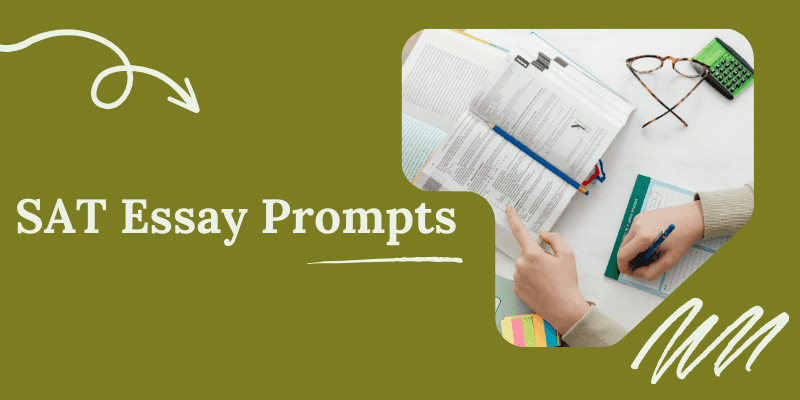
Relevant Articles
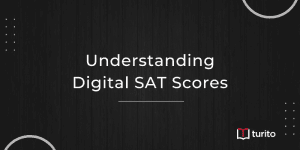
Strategies for Success: Mastering the Digital SAT Scoring System
Securing good marks on the digital SAT is important for …
Strategies for Success: Mastering the Digital SAT Scoring System Read More »

Is the Digital SAT Easier? New Format & Adaptive Testing
With multiple speculations on the introduction of the newer SAT …
Is the Digital SAT Easier? New Format & Adaptive Testing Read More »

Is the Digital SAT Harder? Exploring Changes, Similarities & Prep
High school students take the SAT or Scholastic Assessment Test …
Is the Digital SAT Harder? Exploring Changes, Similarities & Prep Read More »

How is the Digital SAT Scored?
The digital SAT emerges as a modernized approach to testing …
How is the Digital SAT Scored? Read More »

With Turito Study Abroad

Get an Expert Advice from Turito

With Turito CAP.

With Turito Coding.

With Turito RoboNinja

1-on-1 tutoring for the undivided attention

SAT Essay Prompts - January 2013
Materials on this page relate to the sat before march 2016..
- New SAT Prep
The following are the SAT essay prompts given for January 2013.
We have a collection of the new SAT Essay Prompts , ordered according to years, from March 2005 till the most recent test released by College Board.
January 2013 SAT Essay Prompt
If you took the January 2013 SAT, you would have been given one of the essay prompts below:
Think carefully about the issue presented in the following excerpt and the assignment below.
People generally prefer originality to imitation, which is often considered inferior and second-rate. However, we have learned most of what we know by imitating others. Mastering any skill or gaining any knowledge means that we must learn from those who have gone before us. In fact, it is not until we have imitated others and learned from them what there is to know that we can strike out on our own and maybe create something new.
Assignment:
Is it necessary for people to imitate others before they can become original and creative? Plan and write an essay in which you develop your point of view on this issue. Support your position with reasoning and examples taken from your reading, studies, experience, or observations.
Many people say that money is not the most important thing in life and that being overly concerned about money leads only to unhappiness. Others point out, however, that money and wealth have always been of dramatic significance in society. They argue that there is really nothing more important to one's overall quality of life than money.
Is money the most significant factor in determining a person's quality of life? Plan and write an essay in which you develop your point of view on this issue. Support your position with reasoning and examples taken from your reading, studies, experience, or observations.
Young people are highly influenced by popular culture. They attempt to define themselves on the basis of what they see on television, in newspapers and magazines, and in the movies. In fact, young people accept the values of popular culture as their own, believing that those values are central to their personal development and social acceptance.
Is popular culture the strongest influence on a young person's identity? Plan and write an essay in which you develop your point of view on this issue. Support your position with reasoning and examples taken from your reading, studies, experience, or observations.
Many people believe that our behavior should be consistent, that we should always be ourselves. They feel that we should not act one way with some people and another way with others. But is this right? Should our behavior always be consistent, or should we behave differently in different situations? Isn't behaving differently according to the people we are with or the situation we are in simply a matter of politeness and common sense?
Should people change their behavior depending on what situation they are in? Plan and write an essay in which you develop your point of view on this issue. Support your position with reasoning and examples taken from your reading, studies, experience, or observations.

We welcome your feedback, comments and questions about this site or page. Please submit your feedback or enquiries via our Feedback page.


IMAGES
VIDEO
COMMENTS
No extra time allowed! #5: Grade the essay, using the official essay rubric to give yourself a score out of 8 in the reading, analysis, and writing sections. #6: Repeat steps 4 and 5. Choose the prompts you think will be the hardest for you so that you can so that you're prepared for the worst when the test day comes.
A complete compilation of real SAT essay prompts administered historically by the College Board for different test periods. Prompts: October 2014 - June 2015. Prompts: October 2013 - June 2014. Prompts: October 2012 - June 2013. Prompts: October 2011 - June 2012. Prompts: October 2010 - June 2011.
Adapted from Paul Bogard, "Let There Be Dark." ©2012 by Paul Bogard. Originally published in Los Angeles Times, December 21, 2012. At my family's cabin on a Minnesota lake, I knew woods so dark that my hands disappeared before my eyes. I knew night skies in which meteors left smoky trails across sugary spreads of stars.
SAT Essay Prompts (October 2013 - June 2014 ) June 2014. Prompt 1 . Think carefully about the issue presented in the following excerpt and the assignment below. What determines success in life is not intelligence or talent, but character: those qualities gained
How to Write an SAT Essay, Step by Step. Learn the ins and outs of writing a perfect-scoring SAT essay by following along as we go through the reading, analyzing and planning, writing, and revising stages of a sample essay. You'll get to see the whole process, from scribbled handwritten planning notes to the polished final product.
SAT Essay Prompt Type 2: Discuss which of two things is better These questions can be fodder for 12-scoring essays because they can be answered so simply: this thing is better than that thing. Then you just have to think of 1-3 examples in which that thing worked and/or in which the other thing didn't work.
1. Prompt Structure: SAT essay prompts typically consist of a passage or excerpt followed by a question that asks you to analyze the author's argument, rhetorical strategies, or persuasive techniques. 2. Key Components: Pay attention to the main argument or thesis presented in the passage, as well as the evidence and rhetorical devices used to ...
The SAT Essay is a lot like a typical writing assignment in which you're asked to analyze a text. To do well on the SAT Essay, you'll want to have a good sense of what the test asks of you as well as the reading, analysis, and writing knowledge and skills required to compose a response to the Essay prompt. This chapter is intended primarily ...
SAT Essay Prompt 1 Reading Passage "Adapted from Paul Bogard, "Let There Be Dark." ©2012 by Los Angeles Times. Originally published December 21, 2012. At my family's cabin on a Minnesota lake, I knew woods so dark that my hands disappeared before my eyes. I knew night skies in which meteors left smoky trails across sugary spreads of stars.
College Board. February 28, 2024. The SAT Essay section is a lot like a typical writing assignment in which you're asked to read and analyze a passage and then produce an essay in response to a single prompt about that passage. It gives you the opportunity to demonstrate your reading, analysis, and writing skills—which are critical to ...
10 Official SAT Essay Prompts For Practice. Practice Test 1. "Write an essay in which you explain how Jimmy Carter builds an argument to persuade his audience that the Arctic National Wildlife Refuge should not be developed for industry.". Practice Test 2.
If you took the October 2013 SAT, you would have been given one of the essay prompts below: Prompt 1. Think carefully about the issue presented in the following excerpt and the assignment below. Most people think that contentment—being happy with the way things are—is the perfect state of affairs.
write an essay in which you develop your point of view on this issue. Support your position with reasoning and examples taken from your reading, studies, experience, or observations. May 2013 . Prompt 1 . Think carefully about the issue presented in the following excerpt and the assignment below. People use the term "wisdom" to mean many things.
This is the argument you need to deconstruct in your essay. Writing an SAT essay consists of four major stages: Reading: 5-10 minutes. Analyzing & Planning: 7-12 minutes. Writing: 25-35 minutes. Revising: 2-3 minutes. There's a wide time range for a few of these stages, since people work at different rates.
The following are the SAT essay prompts given for June 2013. We have a collection of the new SAT Essay Prompts, ordered according to years, from March 2005 till the most recent test released by College Board. Related Topics: More SAT Prep Help More SAT Math Lessons June 2013.
Essay prompts from the most recent SAT administration in October 2013. Below are essay prompts from the most recent SAT administration in October 2013 . Prompt 1 Think carefully about the issue presented in the following excerpt and the assignment be
New SAT Prep; SAT Math; The following are the SAT essay prompts given for March 2013. We have a collection of the new SAT Essay Prompts, ordered according to years, from March 2005 till the most recent test released by College Board. March 2013. If you took the March 2013 SAT, you would have been given one of the essay prompts below: Prompt 1
Essay prompts from the most recent SAT administration inMay 2013. Below are essay prompts from the most recent SAT administration in May 2013 . Prompt 1 Think carefully about the issue presented in the following excerpt and the assignment below. Peop
Here are a couple of examples of statistics from an official SAT essay prompt, "Let There Be Dark" by Paul Bogard: Example: 8 of 10 children born in the United States will never know a sky dark enough for the Milky Way. Example: In the United States and Western Europe, the amount of light in the sky increases an average of about 6% every year.
Below are essay prompts from the most recent SAT administration in November 2013. SAT Essay Prompt 1. Think carefully about the issue presented in the following excerpt and the assignment below. We are often reminded that acquiring and owning material possessions—money, property, jewelry, even clothing—will not lead to true happiness. ...
The criteria for judgment and scoring are reading, analysis, and writing. Each evaluator judges the essay with a score ranging between 1 to 4 points. The scores awarded by the two invigilators will be added for each criterion. Students will receive three different scores ranging between 2 to 8 points. The SAT essay score does not include ...
SAT Math; The following are the SAT essay prompts given for January 2013. We have a collection of the new SAT Essay Prompts, ordered according to years, from March 2005 till the most recent test released by College Board. January 2013 SAT Essay Prompt. If you took the January 2013 SAT, you would have been given one of the essay prompts below ...